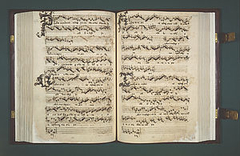Two sources, lots of material for research – the digital Annaberger Chorbücher
Dr. Andrea Hammes
Thursday, July 28, 2016

The two Annaberg choirbooks described below have been documented by the RISM working group in Dresden and are detailed in the RISM online catalog. The two manuscript collections can be found at the SLUB with the shelfmarks Mus.1-D-505 (link in RISM) and Mus.1-D-506 (link in RISM). The RISM records were used as metadata for the choirbooks in the SLUB’s digital collections.
The following post originally appeared on the SLUBlog and is published here with kind permission.
Two particularly important items of sixteenth-century Saxon church music heritage are choirbooks from Annaberg, which were manuscripts used in the church that offer a fascinating glimpse into the cultivation of music during the Reformation. Now the volumes, which are among the special treasures of the Music Department, have been digitized as part of a state-funded digitization program. As of now, the electronic versions of the choirbooks may be freely viewed online through the SLUB’s Digital Collections.
The collective manuscripts (also known as Annaberger Chorbuch I and II; SLUB shelfmarks Mus.1-D-505 and Mus.1-D-506, respectively) probably originated in the early sixteenth century and are thus likely from the pre-Reformation time. Supporting this dating are composers such as Antoine Brumel, Loyset Compère, Alexander Agricola, Heinrich Isaac, and Josquin Desprez, as well as Catholic content. Both codices offer a mix of mostly four-part Latin church music: masses, individual mass movements, settings of the Magnificat, motets, and a collection of hymns and introits. Although the Reformation did not reach Albertine Saxony (and thus Annaberg) until 1539, the choirbooks were nonetheless probably not created for the church upon its consecration in 1519. Rather, they came into being even earlier in Ernestine Saxony, possibly in Wittenberg, as part of a larger pool of sources that reflects the “Electorate of Saxony-Ernestine court music cultivation around and after 1500” (in W. Steude’s formulation). There, rendered unusable by the Reformation, the volumes ended up in Annaberg. The choirbooks belonged to the church library at St. Annen until 1968 when they were transferred to the collections of the then-Saxon State Library. Now, after being restored (in 1969/70) and digitized, there are different ways to experience and explore them: virtually in the form of high-quality digital surrogates, and in person in the Treasure Room of the SLUB alongside other highlights from the SLUB’s collections.
Now that Annaberger Chorbuch II has been available since 2010 in a critical edition in the series “Erbe deutscher Musik” under the direction of Wolfgang Horn, a new edition of Chorbuch I should follow shortly. The interplay between the original and a critical assessment of the source is sure to provide new impetus for research, such as the identification of additional anonymous works, which in both volumes are not the exception but rather the rule.
Share Tweet EmailCatégorie: Collections de bibliothèques

